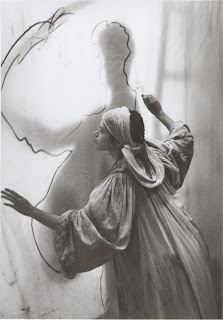
The Feast Day of St. Cecilia is in November, but the Santa Cruz Chorale is celebrating early this year with three upcoming concerts of vintage and modern choral music. Under the baton of maestro Christian Grube (founder of the renowned Chamber Choir of Berlin), the Chorale will perform its annual summer concert three times, at two venues, the weekend of June 17, 18, and 19.
As the patron saint of music (particularly organ and church music) and of vocalists, Cecilia has seen a great many compositions dedicated to her over the centuries, in honor of her Feast Day. The Chorale program features Ode for St. Cecilia's Day (with the tantalizing subtitle, Welcome to All the Pleasures) by 17th Century English composer Henry Purcell, along with several other short Purcell pieces. Also included will be two pieces of 20th Century English composer Benjamin Britten (actually born on St. Cecilia's Day, November 22), including his Hymn to St. Cecilia. Finally, the Chorale will sing two chants by Santa Cruz's own Lou Harrison.
Live choral music is indeed one of life's great pleasures. Even if you crank your speakers up to eleven, you just can't get the same effect at home, so make plans to go see (and hear) this accomplished community chorale in action at one of these appearances: in Watsonville, at Our Lady Help of Christians Church, Friday June 17, at 7 pm, or in Santa Cruz at Holy Cross Church, Saturday, June 18, at 8 pm, or Sunday, June 19, at 4 pm. Visit the SC Chorale
website for more info.
Like most Catholic saints, Cecilia is said to have suffered a gory martyrdom for the crime of converting locals to Christianity in the 2nd or 3rd Century Rome (or Sicily, in some versions). In the portrait above, Italian Renaissance artist Aremisia Gentileschi chose to paint a less grisly image of Cecilia at her keyboard. Not known for playing any musical instruments in her life, Cecilia is famed for having sung to God during the lengthy process of her dying, for which she was rewarded, after a couple of centuries, by being named patroness of singing and music. She's most often pictured at an organ, although frequently seen playing a lyre, a harp, or a lute, like one of the Greek muses, an altogether more festive way to be remembered.
Speaking of Art triumphing over gritty reality, consider Artemisia herself. One of the very few female artists of her (or any) era even remembered today, she had to go through
all the artistic struggles of her male counterparts, but she had to do it in a dress, under the thumb of dominant men. Apprenticed by her artist father, Orazio Gentileschi, to a randy master painter who raped her, she endured a lengthy trial during which, among other indignities, she was tortured to recant her accusation. (She didn't, and the man was finally convicted.) Small wonder she chose to paint Cecilia in a moment of such serene transcendence. (Although if you want to know how she really felt, compare her searing painting of the Biblical scene "
Judith Beheading Holofernes.")
ART vs. FILM
Artemisia was also the subject of a 1997
film by French filmmaker Agnes Merlet. By most accounts, it was pretty dreadful, a hothouse romance that played fast and loose with the facts of the artist's life. (No surprise there; since when is a movie bio ever factual?) But I'm still dying to see it one day, especially if it looks as luscious as this still, and because I'm such a sucker for movies about artists and the creative process.
Movies about writers tend to be fairly static because, let's face it, writing is not a spectator sport. (Woody Allen's excellent new comedy, Midnight In Paris, excepted; it's not about writers actually writing, but about writers after hours, living la vie boheme, which is a lot more fun to watch. But more on that next post!)
Because the act of writing is not terribly cinematic, filmmakers always try to tart it up with action, most of it highly dubious. It can work sometimes: remember the giant cockroaches crawling out of Charles Bukowski's typewriter in Naked Lunch? Okay, he's on drugs, but what a metaphor; who hasn't occasionally felt that kind of fear and loathing while staring at the ravenous keyboard?
But most of these faux-action gimmicks are completely spurious, like Jane Fonda (as Lillian Hellman) throwing her typewriter out the window in Julia. It's the Depression, and she throws the means of earning her living out the window? Oh, please.

In movies about artists, however, at least there's something to look at as the creative process goes on. In Camille Claudel, eponymous star Isabelle Adjani, and Gerard Depardieu as Auguste Rodin (she's his apprentice, muse, and lover), sculpt mighty works together, even as she sinks into dementia, unrecognized, in the shadow of her more famous mentor. In Carlos Saura's succulent and disturbing fantasia, Goya In Bordeaux, we see the elderly Spanish painter (played by Francisco Rabal as a reckless old bull) splashing electrifying images of death and tragedy all around the walls of his home in the dead of night, in a hat crowned with candles to see by. In Frida, we get a twofer: Salma Hayek's Frida staging and painting her richly symbolic self-portraits, along with filmmaker Julie Taymor creating vivid, Kahlo-esque compositions out of the drama onscreen.
Watching a movie about art is not the next best thing to making art yourself, not by a longshot. But you never know what random image, or scrap of dialogue, or phrase of choral music will trigger your own inner maestro.
 Cabrillo Stage's fun, raucous 'Full Monty' delivers the goods
Cabrillo Stage's fun, raucous 'Full Monty' delivers the goods








